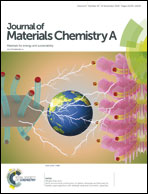Carbon capture with polyethylenimine hydrogel beads (PEI HBs)†
Abstract
A new class of CO2 sorbents, namely polyethylenimine hydrogel beads (PEI HBs), has been developed via a simple one-step crosslinking reaction of PEI using epichlorohydrin (EPC). The beads have an increased surface area which increases the CO2 uptake compared to the liquid PEI. Moreover, they possess exceptional thermal stability so the issues with solvent loss encountered with conventional amines are avoided. In contrast to the majority of other reported PEI-functionalized CO2 sorbents, PEI HBs perform well under humid conditions. More importantly, PEI HBs can be quickly and easily regenerated via microwave heating. This new material extends the application of hydrogels and may shed light on the development of other functional materials apart from CO2 sorbents.



 Please wait while we load your content...
Please wait while we load your content...